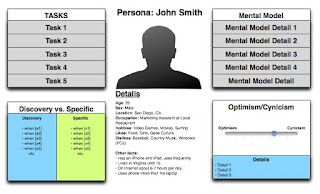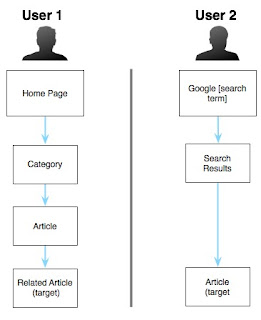人物誌:以使用者為中心來進行設計
人物誌在 HCI / GUI / UI / UX 等領域,透過使用者原型的描繪,凝聚團隊共識,確認每一項功能是否符合使用者需求的方法。
如何設定「人物誌」
- 年齡
- 性別
- 職業
- 愛好
- 喜歡/不喜歡
- 其他細節有密切關係的產品
如何制訂通用設計
通用設計講白話點就是要如何使目標族群易於使用,舉網頁設計的產品為例,為吸引目標使用者針對喜好商品進行排版,使其族群進行操作點閱,以達成商品銷售。(圖片是臨時抓奇摩網站的 @@'')
設定任務
開發團隊設定了什麼任務?一般的應用型主題或更具體地一個流程項目。
當開發多種角色時,最常遇到的問題:最需要問的是 「是否有不同的角色不同的任務?」
定義人物角色可以幫助發現新的使用案例,正在設計目標族群的人物角色代表了相匹配的任務是什麼?
設計師瞭解自己設定的任務路徑,但人物誌最終可能會採取不同的路徑,這可能反過來影響當初的設計,需要有更多的互動設計引導回原本的設計路徑上,以利完成最初的設計設定。
互動設計目的
Alan Cooper(2007) 認為 Personas 應用在設計上,可以達成以下目的:
- 決定產品規格與作用。Personas 所定義的目的與任務,可以提供設計工作的基礎。Determine what a product should do and how it should behave. Persona goals and tasks provide the foundation for the design effort.
- 與團隊中不同成員溝通。Personas 是設計決策討論中的共通語言,能幫助設計的各個階段都能聚焦在使用者上。 Communicate with stakeholders, developers, and other designers. Personas provide a common language for discussing design decisions and also help keep the design centered on users at every step in the process.
- 建立共識,釐清設計主張。減少發展複雜的使用者圖解模型。 Build consensus and commitment to the design. With a common language comes a common understanding. Personas reduce the need for elaborate diagrammatic models; it's easier to understand the many nuances of user behavior through the narrative structures that personas employ. Put simply, because personas resemble real people, they're easier to relate to than feature lists and flowcharts.
- 測量設計效力。Personas 無法取代以真人來進行測試的有效性,但提供設計者一個解決設計問題的有效的工具,並在真人測試前提供一個有力的設計基準。Measure the design's effectiveness. Design choices can be tested on a persona in the same way that they can be shown to a real user during the formative process. Although this doesn't replace the need to test with real users, it provides a powerful reality-check tool for designers trying to solve design problems. This allows design iteration to occur rapidly and inexpensively at the whiteboard, and it results in a far stronger design baseline when the time comes to test with actual people.
- 協助其他與產品相關的工作,如行銷與銷售計畫擬定。Contribute to other product-related efforts such as marketing and sales plans. The authors have seen their c1ientsrepurpose personas across their organization, informing marketing campaigns, organizational structure, and other strategic planning activities. Business units outside of product development desire sophisticated knowledge of a product's users and typically view personas with great interest.
人物誌流程設計
圖片來源:http://personas.dk/?page_id=196
步驟1.Find the Users 找出使用者
[發問] 使用者是誰? 使用者有多少? 使用者在系統當中可以做些甚麼?
[可以運用的方法]量化資料的收集
[預期成果]報告
步驟2.Building a Hypothesis 建立假設
[發問] 他們在使用者中差異在哪裡?
[可以運用的方法]
I.分析研究素材料;
II.把使用者分類;
III.區辨使用者並予以命名。
[預期成果] 目標團體的描述初稿
步驟3.Verification 驗證
[發問]
(1)人物誌資料:I.喜歡/不喜歡;II.內在的需求;III.價值觀
(2)情境資料:I.工作領域;II.工作條件
(3)劇本資料:I.工作策略與目標;II.資訊策略與目標
[可以運用的方法] 質性資料的蒐集
[預期成果] 報告
步驟4.Finding Patterns找出模式
[發問]
(1)一開始的分類是否能夠掌握全貌?
(2)是否有其他的群體要考慮進來?
(3)是否都一樣的重要?
[可以運用的方法] 分門別類
[預期成果] 不同類別的敘述
步驟5.Constructing Personas 建構人物誌
[發問]
(1)身體(名字、年齡、照片)
(2)心理狀態(內向的人、外向的人)
(3)背景(職業)
(4)感情與態度(對科技的傾向、公司(傳遞者)、資訊)
(5)個人特質
[可以運用的方法]分門別類
[預期成果]類別的描述
步驟6.Defining Situations 定義情境
[發問]
(1)這個人物誌的需求是甚麼?
(2)情境是甚麼?
[可以運用的方法]情境與需求的資料分析
[預期成果]需求與情境的目錄(catalogue)
步驟7.Validation and Buy-in 確認與採納
[發問]你知道有人是像這樣的嗎?
[可以運用的方法]找熟用人物誌的人解讀並與評論其表述。
步驟8.Dissemination知識的推播
[發問]我們如何在組織當中分享人物誌的研究成果?
[可以運用的方法]海報、會議、電子郵件、
[預期成果]每一種類型人物誌的積極活動與事件。
步驟9.Creating Scenario 創作劇本
[發問]既有環境下以現成目標來討論當人物誌這個角色使用了新技術後會發生甚麼事?
[可以運用的方法]
敘事性劇本:使用人物誌以及形成劇本的情境與敘述。
[預期成果]劇本、使用案例、需求條件、詳細訂定規格。
步驟10. On-going Development 持續進展
[發問]新的資訊是否改變了人物誌?
[可以運用的方法]使用性測試、 收集新資料、所有關於與使用者互動的回饋意見,
例如:販售、支援系統與訓練者。
[預期成果]基礎文件
結論
人物角色幫助設計師設定的使用族群有更好的瞭解,以驗證設計是否滿足使用者的需求,關於人物誌最有幫助的地方是,可以利用文件具體的呈現,節省了很多時間成本、非必要的開發時間,以任何方式適合進行分析工作流程都是最好的,人物誌是使用者經驗設計在人物情境、狀態設定很有用的一個開發方式。
- Jenkinson , A . ( 1994 ) ‘Beyond segmentation’http://www.centreforintegratedmarketing.com/gfx/documents/beyond_segmentation.pdf
- Cooper, Alan. ( 1999) The Inmates Are Running the Asylum: Why High Tech Products Drive Us Crazy and How to Restore the Sanity. Google books and Notes from the book
- Personas: The Foundation of a Great User Experience http://uxmag.com/articles/personas-the-foundation-of-a-great-user-experience
- Persona的十個步驟 http://mediaproplus.blogspot.tw/2014/07/persona.html
- Persona(s) [人物角色/代面] http://www.xxc.idv.tw/dokuwiki/personas
- 使用者人物設定 http://www.uxforthemasses.com/personas/




沒有留言:
張貼留言